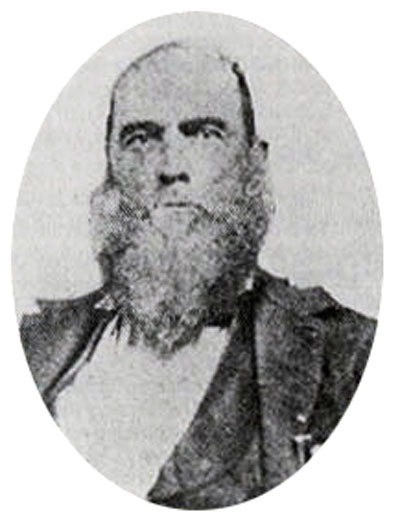|
Squire Ensworth's Letters to Mr. Whaley
Provide Insight to 1860's San Diego
By Dean Glass

1858 brought hardship and disaster to Thomas Whaley and his family. Their son Thomas Jr. died in January, and in August, an incendiary fire in Whaley's store on the north side of the plaza caused the loss of the building and $3000 dollars in merchandise. Discouraged, Whaley decided to leave San Diego and return with his family to San Francisco.
When he left in January of 1859, Whaley turned his affairs in Old Town including his house over to Wells Fargo agent Frank Ames, whose employment was terminated the following October. The 1860 Census recorded the occupants of the house for June of that year; they included Robert E. and Sarah Doyle. Doyle was an agent from the San Antonio - San Diego overland mail line. Living with them were two of the company's mail carriers, James Mason and Samuel A. Ames, and Gabriel Padres of New Mexico, for whom no occupation was listed. That summer the Doyles were evicted for non-payment of rent, and in July Augustus S. Ensworth moved into Thomas Whaley's house and managed his business interests.
According to William E. Smythe's History of San Diego, "A. S. 'Squire' Ensworth came to San Diego as a teamster in government employ. He was elected justice of the peace in 1856 and assemblyman in 1859. He was a 'self-made man,' who studied law after being elected justice, and later engaged in the practice of law, with considerable success. He was quite a reader and had a large library, for the times."
In May of 1863, Ensworth filed claim to 160 acres of land that included a spring. He built a two-room adobe on the property, the first house erected by a white man in the eastern part of San Diego County. The wood used for beams and doorways was salvaged from the ship Clarissa Andrews, which had run aground in San Diego Harbor. Before Ensworth died, he sold the property to Captain Rufus King Porter for $400. (It was Captain Porter who renamed the area Spring Valley and was its first postmaster, and named Mt. Helix after a newly discovered snail.) The house still stands and is now operated as the Bancroft House Ranch Museum.
Although information about Ensworth's activities before arriving in San Diego in the early 1850s is elusive, the University of Texas at Austin's Handbook of Texas Online lists an Augustus S. Ensworth who was a "soldier, land commissioner, and legislator, [who] probably arrived in Texas during the Texas Revolution. He served in the Army of the Republic of Texas from November 3, 1836, until November 11, 1837, and settled at Goliad, where he was elected chief justice on January 1, 1840. He resigned to become commissioner to inspect the county land office on January 31, 1840. He later served in the House of the Fifth Congress of the republic, from November 2, 1840, to February 5, 1841. On February 24, 1851, he was issued an unconditional land certificate at Goliad. He was not listed in the 1850 Census." Given the fact that the Texas Ensworth disappeared from that state around 1850, and the San Diego Ensworth arrived in Old Town around the same time and seemed to have a healthy interest in the state of Texas (he mentions five different books about the history of Texas in his letters to Whaley), it seems likely that they are one and the same.
Ensworth died at Sisters of Charity Hospital in Los Angeles on September 13, 1865 at the age of 54.
While he resided in the Whaley House between 1860 and 1863, Augustus S. Ensworth corresponded regularly with Thomas Whaley. While Whaley's replies are evidently missing or no longer exist, transcribed copies of the text of most of the letters written by Ensworth can be perused at the Whaley House or by logging on to www.whaleyhouse.org. Since there was no newspaper published in San Diego for most of the 1860s, these letters provide a rare glimpse into the day-to-day existence of San Diegans during those depressed times.
Special thanks to Ronald J. Quinn, who compiled, transcribed, and edited the Ensworth Letters.
Sources
Flanigan, S. Kathleen, Whaley Chronology, SOHO, 2000
Pourade, Richard F., The Silver Dons, San Diego Copley Press, 1963
Quinn, Ronald J., editor, "If Only You Could Send Me a Strong and Sound Leg": Letters of A. S. Ensworth to Thomas Whaley, 1862-1865; The Journal of San Diego History, Winter 1997
Smythe, William E., History of San Diego, 1542-1907; San Diego: The History Company, 1908.
University of Texas at Austin's Handbook of Texas Online www.tsha.utexas.edu/handbook/online/articles/EE/fen6.html
Squire Augustus S. Ensworth photo courtesy SDHS collection. |
MORE FROM THIS ISSUE
Root of the Problem?
Is it Worth Saving?
Making History
New Project to Reconfigure Tank Farm
Coronado City Council Upholds Designation by the City's Historical Resources Commission
Historic Preservation: The Greenest of Conservation Solutions
Adobe U
The Preservation and Repair of Historic Stucco
Borrego Springs Modern
Modern for the Masses
Community Outreach
Old Town Cultural/Historical Program
Annual Report
Statement of Activities
Statement of Financial Position
Head Docent Promoted
In Memoriam: Lee Roper (1929-2006)
Squire Ensworth's Letters to Mr. Whaley
Whaley House Garden
Volunteer Profile: Pat Petersen
SOHO Highlights San Diego County Museums
1938 Midway La Playa Trail Refurbished & Unveiled
What is it?
Strength in Numbers
Lost San Diego
DOWNLOAD full magazine as pdf (8.9mb)
|




